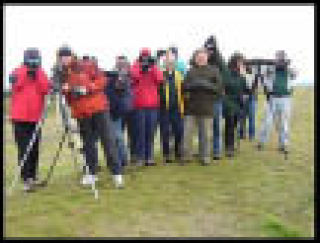When we start to see swans it’s time to think Christmas Bird Count! Set this date aside – Saturday, December 19 for the Christmas Bird Count with San Juan Islands Audubon Society. Besides walking around in the snow and climbing over downed trees after a big wind storm you may be the first one to record Western Bluebirds for the count! You don’t necessarily have to go out with a group – you could count birds on your road with your neighbors or by yourself or with your family in you own yard or on your property. So spend part or all of the day with great people counting birds. You don’t have to be an expert but you do have to have enthusiasm for nature.
Even if you don’t count please let us know if you see any of these species the week of the count or let us know ahead of time so we can look for them: small hawks, mourning doves, owls, hummingbirds, sapsuckers, shrikes, jays, and western bluebirds. If you live on the shoreline we need your help with shorebirds and marine birds.
Many routes need better coverage so call today to see what we have for you. For more information and to join call: Barbara Jensen, 378-3068.
A Bit of History – In 1900 ornithologist Frank Chapman along with other conservationists were disturbed at the slaughter of birds in the annual holiday event called the “side hunt.” The team that shot the most birds and other small animals was the winner. As a protest, Chapman organized 27 friends in 25 locations on Christmas Day, 1900 to count live animals instead of shooting them.
From Bird Hunts – To Birds Counts
Today, hundreds of people will choose a 24-hour time period during the holiday season to record every bird seen or heard in their designated 15-mile diameter circle – about 177 square miles. So why is this data important? Bird populations are indicators of the overall health of our environment. As the database continues to grow and becomes long-term, it is possible to monitor the abundance and distribution patterns of wintering bird populations. If you go to Audubon’s website at: http://www.audubon.org/bird/cbc/getinvolved.html you can look at the results from our area, make charts, and look at trends for specific species. Help us this year by giving Barb a call.



